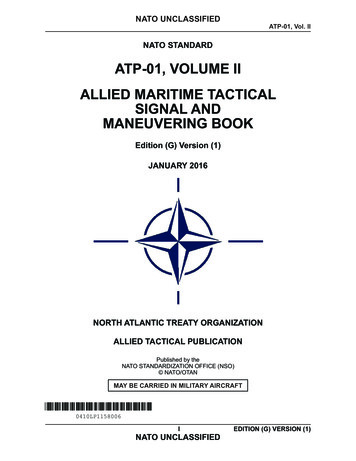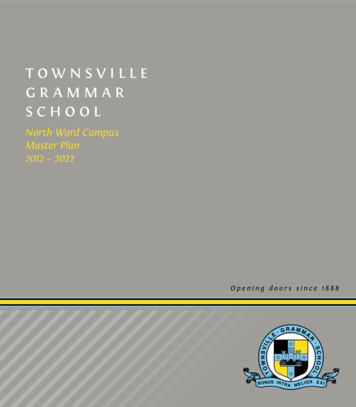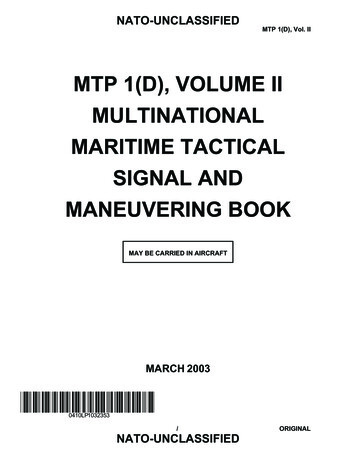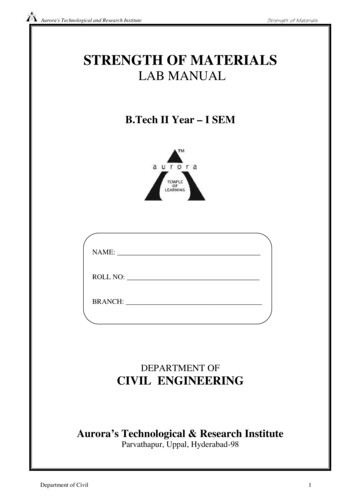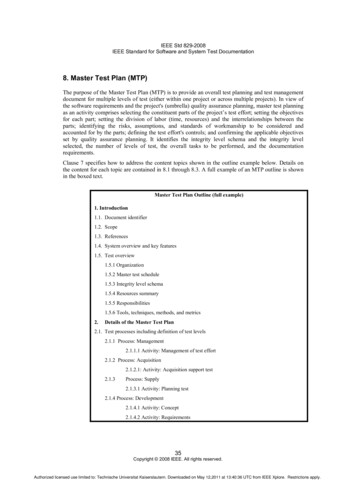
Transcription
IEEE Std 829-2008IEEE Standard for Software and System Test Documentation8. Master Test Plan (MTP)The purpose of the Master Test Plan (MTP) is to provide an overall test planning and test managementdocument for multiple levels of test (either within one project or across multiple projects). In view ofthe software requirements and the project's (umbrella) quality assurance planning, master test planningas an activity comprises selecting the constituent parts of the project s test effort; setting the objectivesfor each part; setting the division of labor (time, resources) and the interrelationships between theparts; identifying the risks, assumptions, and standards of workmanship to be considered andaccounted for by the parts; defining the test effort's controls; and confirming the applicable objectivesset by quality assurance planning. It identifies the integrity level schema and the integrity levelselected, the number of levels of test, the overall tasks to be performed, and the documentationrequirements.Clause 7 specifies how to address the content topics shown in the outline example below. Details onthe content for each topic are contained in 8.1 through 8.3. A full example of an MTP outline is shownin the boxed text.Master Test Plan Outline (full example)1. Introduction1.1. Document identifier1.2. Scope1.3. References1.4. System overview and key features1.5. Test overview1.5.1 Organization1.5.2 Master test schedule1.5.3 Integrity level schema1.5.4 Resources summary1.5.5 Responsibilities1.5.6 Tools, techniques, methods, and metrics2.Details of the Master Test Plan2.1. Test processes including definition of test levels2.1.1 Process: Management2.1.1.1 Activity: Management of test effort2.1.2 Process: Acquisition2.1.2.1: Activity: Acquisition support test2.1.3Process: Supply2.1.3.1 Activity: Planning test2.1.4 Process: Development2.1.4.1 Activity: Concept2.1.4.2 Activity: Requirements35Copyright 2008 IEEE. All rights reserved.Authorized licensed use limited to: Technische Universitat Kaiserslautern. Downloaded on May 12,2011 at 13:40:36 UTC from IEEE Xplore. Restrictions apply.
IEEE Std 829-2008IEEE Standard for Software and System Test Documentation2.1.4.3 Activity: Design2.1.4.4 Activity: Implementation2.1.4.5 Activity: Test2.1.4.6 Activity: Installation/checkout2.1.5 Process: Operation2.1.5.1 Activity: Operational test2.1.6 Process: Maintenance2.1.6.1 Activity: Maintenance test2.2. Test documentation requirements2.3. Test administration requirements2.4. Test reporting requirements3.General3.1. Glossary3.2. Document change procedures and history8.1 (MTP Section 1) IntroductionIntroduce the following subordinate sections. This section identifies the document and places it incontext of the project-specific lifecycle. It is in this section that the entire test effort is described,including the test organization, the test schedule, and the integrity schema. A summary of requiredresources, responsibilities, and tools and techniques may also be included in this section.8.1.1 (MTP Section 1.1) Document identifierUniquely identify a version of the document by including information such as the date of issue, theissuing organization, the author(s), the approval signatures (possibly electronic), and the status/version(e.g., draft, reviewed, corrected, or final). Identifying information may also include the reviewers andpertinent managers. This information is commonly put on an early page in the document, such as thecover page or the pages immediately following it. Some organizations put this information at the endof the document. This information may also be kept in a place other than in the text of the document(e.g., in the configuration management system or in the header or footer of the document).8.1.2 (MTP Section 1.2) ScopeDescribe the purpose, goals, and scope of the system/software test effort. Include a description of anytailoring of this standard that has been implemented. Identify the project(s) for which the Plan is beingwritten and the specific processes and products covered by the test effort. Describe the inclusions,exclusions, and assumptions/limitations. It is important to define clearly the limits of the test effort forany test plan. This is most clearly done by specifying what is being included (inclusions) and equallyimportant, what is being excluded (exclusions) from the test effort. For example, only the current newversion of a product might be included and prior versions might be excluded from a specific test effort.In addition, there may be gray areas for the test effort (assumptions and/or limitations) wheremanagement discretion or technical assumptions are being used to direct or influence the test effort.For example, system subcomponents purchased from other suppliers might be assumed to have beentested by their originators, and thus, their testing in this effort would be limited to only test the featuresused as subcomponents in the new system.36Copyright 2008 IEEE. All rights reserved.Authorized licensed use limited to: Technische Universitat Kaiserslautern. Downloaded on May 12,2011 at 13:40:36 UTC from IEEE Xplore. Restrictions apply.
IEEE Std 829-2008IEEE Standard for Software and System Test DocumentationIt is implied that the test tasks will reflect the overall test approach and the development methodology.If the development is based on a waterfall methodology, then each level of the test will be executedonly one time. However, if the development is based on an iterative methodology, then there will bemultiple iterations of each level of test. For example, component testing may be taking place on themost recent iteration at the same time that acceptance testing is taking place on products that weredeveloped during an earlier iteration.The test approach identifies what will be tested and in what order for the entire gamut of testing levels(component, component integration, system, and acceptance). The test approach identifies the rationalefor testing or not testing, and it identifies the rationale for the selected order of testing. The testapproach describes the relationship to the development methodology. The test approach may identifythe types of testing done at the different levels. For example, thread testing may be executed at asystem level, whereas requirements testing may take place at the component integration as well as ata systems integration level.The documentation (LTP, LTD, LTC, LTPr, LTR, and LITSR) required is dependent on the selectionof the test approach(es).8.1.3 (MTP Section 1.3) ReferencesList all of the applicable reference documents. The references are separated into external referencesthat are imposed external to the project and internal references that are imposed from within to theproject. This may also be at the end of the document.8.1.3.1 (MTP Section 1.3.1) External referencesList references to the relevant policies or laws that give rise to the need for this plan, e.g.:a)Lawsb) Government regulationsc)Standards (e.g., governmental and/or consensus)d) PoliciesThe reference to this standard includes how and if it has been tailored for this project, an overview ofthe level(s) of documentation expected, and their contents (or a reference to an organizational standardor document that delineates the expected test documentation details).8.1.3.2 (MTP Section 1.3.2) Internal referencesList references to documents such as other plans or task descriptions that supplement this plan, e.g.:a)Project authorizationb) Project plan (or project management plan)c)Quality assurance pland) Configuration management plan8.1.4 (MTP Section 1.4) System overview and key featuresDescribe the mission or business purpose of the system or software product under test (or referencewhere the information can be found, e.g., in a system definition document, such as a Concept ofOperations). Describe the key features of the system or software under test [or reference where theinformation can be found, e.g., in a requirements document or COTS documentation].37Copyright 2008 IEEE. All rights reserved.Authorized licensed use limited to: Technische Universitat Kaiserslautern. Downloaded on May 12,2011 at 13:40:36 UTC from IEEE Xplore. Restrictions apply.
IEEE Std 829-2008IEEE Standard for Software and System Test Documentation8.1.5 (MTP Section 1.5) Test overviewDescribe the test organization, test schedule, integrity level scheme, test resources, responsibilities,tools, techniques, and methods necessary to perform the testing.8.1.5.1 (MTP Section 1.5.1) OrganizationDescribe the relationship of the test processes to other processes such as development, projectmanagement, quality assurance, and configuration management. Include the lines of communicationwithin the testing organization(s), the authority for resolving issues raised by the testing tasks, and theauthority for approving test products and processes. This may include (but should not be limited to) avisual representation, e.g., an organization chart.8.1.5.2 (MTP Section 1.5.2) Master test scheduleDescribe the test activities within the project life cycle and milestones. Summarize the overall scheduleof the testing tasks, identifying where task results feed back to the development, organizational, andsupporting processes (e.g., quality assurance and configuration management). Describe the taskiteration policy for the re-execution of test tasks and any dependencies.8.1.5.3 (MTP Section 1.5.3) Integrity level schemeDescribe the identified integrity level scheme for the software-based system or software product, andthe mapping of the selected scheme to the integrity level scheme used in this standard. If the selectedintegrity level scheme is the example presented in this standard, it may be referenced and does notneed to be repeated in the MTP. The MTP documents the assignment of integrity levels to individualcomponents (e.g., requirements, functions, software modules, subsystems, non-functionalcharacteristics, or other partitions), where there are differing integrity levels assigned within thesystem. At the beginning of each process, the assignment of integrity levels is reassessed with respectto changes that may need to be made in the integrity levels as a result of architecture selection, designchoices, code construction, or other development activities.8.1.5.4 (MTP Section 1.5.4) Resources summarySummarize the test resources, including staffing, facilities, tools, and special procedural requirements(e.g., security, access rights, and documentation control).8.1.5.5 (MTP Section 1.5.5) ResponsibilitiesProvide an overview of the organizational content topic(s) and responsibilities for testing tasks.Identify organizational components and their primary (they are the task leader) and secondary (they arenot the leader, but providing support) test-related responsibilities.8.1.5.6 (MTP Section 1.5.6) Tools, techniques, methods, and metricsDescribe documents, hardware and software, test tools, techniques, methods, and test environment tobe used in the test process. Describe the techniques that will be used to identify and capture reusabletestware. Include information regarding acquisition, training, support, and qualification for each tool,technology, and method.Document the metrics to be used by the test effort, and describe how these metrics support the testobjectives. Metrics appropriate to the Level Test Plans (e.g., component, component integration,system, and acceptance) may be included in those documents (see Annex E).38Copyright 2008 IEEE. All rights reserved.Authorized licensed use limited to: Technische Universitat Kaiserslautern. Downloaded on May 12,2011 at 13:40:36 UTC from IEEE Xplore. Restrictions apply.
IEEE Std 829-2008IEEE Standard for Software and System Test Documentation8.2 (MTP Section 2) Details of the Master Test PlanIntroduce the following subordinate sections. This section describes the test processes, testdocumentation requirements, and test reporting requirements for the entire test effort.8.2.1 (MTP Section 2.1) Test processes including definition of test levelsIdentify test activities and tasks to be performed for each of the test processes described in Clause 5 ofthis standard (or the alternative test processes defined by the user of this standard), and document thosetest activities and tasks. Provide an overview of the test activities and tasks for all development lifecycle processes. Identify the number and sequence of levels of test. There may be a different number oflevels than the example used in this standard (component, component integration, system, andacceptance). Integration is often accomplished through a series of test levels, for both componentintegration and systems integration. Examples of possible additional test levels include security,usability, performance, stress, recovery, and regression. Small systems may have fewer levels of test,e.g., combining system and acceptance. If the test processes are already defined by an organization sstandards, a reference to those standards could be substituted for the contents of this subclause.8.2.1.1 (MTP Sections 2.1.1 through 2.1.6) Life cycle 4 processesDescribe how all requirements of the standard are satisfied (e.g., by cross referencing to this standard)if the life cycle used in the MTP differs from the life cycle model in this standard. Testing requiresadvance planning that spans several development activities. An example of test documentation and itsoccurrence during the life cycle is shown in Figure 4. Include sections 2.1.1 through 2.1.6 (or sectionsfor each life cycle, if different from the example used in this standard) for test activities and tasks asshown in the MTP Outline (Clause 8).Address the following eight topics for each test activity (as in the example in Table 4).a)Test tasks: Identify the test tasks to be performed. Table 3 provides example minimum testtasks, task criteria, and required inputs and outputs. Table C.1 provides e
IEEE Std 829-2008 IEEE Standard for Software and System Test Documentation 35 Copyright 2008 IEEE. All rights reserved. 8. Master Test Plan (MTP) The purpose of the Master Test Plan (MTP) is to provide an overall test planning and test management document for multiple levels of test (either withinoneproject or across multiple projects). In viewof
